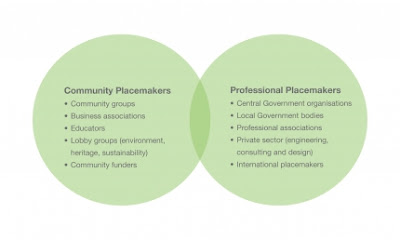Placemaking is the multi-faceted approach to the planning, design and management of public spaces. It involves looking at, listening to and asking questions of the people who live, work and play in a particular area. This is to discover their needs and aspirations. It forms a sense of connection between the communities and the spaces around them. This concept was originally constructed by William H. Whyte who largely pioneered the concept in New York back in the 1970s. It was the beginning of the ‘bottom-up’ approach, where people were the instigators of their own planning initiatives in their communities.
Placemaking is not just the act of building or fixing up a space, but rather a whole process that creates the kind of places where people want to be. Community input is the fundamental factor in the placemaking concept as the success of a public place is determined by the amount of use that the space gets from the local community, therefore if the community has been the fundamental contributor to the project then they have a sense of ownership and therefore are more likely to use it.
Three examples of placemaking in New Zealand are that of the Queen Street revitalisation, the Wellington Waterfront project and the Piopio conversion of empty buildings. Although all of these projects are on different scales they have all been successful in using the bottom-up approach where the community is at the heart of the project and is fully engaged through the design, implementation and monitoring.
 |
| Wellington waterfront (imaged sourced from placemaking.org.nz) |
Placemaking New Zealand have come up with six principles which they believe are important when developing a placemaking project in your community, they are as follows;
1. The locals are the experts
· Get out and meet the locals
· Valuable history of place and functions
· Gives community sense of ownership
2. Create a place not a design
· Work with communities to identify what they want, and actually implement it
3. The whole is greater than the sum of its parts
· Offer multiple options for the community
4. Start with the small stuff
· Experiment with small, short term improvements that can be tested and refined over time
· Elements such as seating, public art, community gardens and murals
5. It’s not about the money
· Don’t need a multimillion dollar budget to create great places
· The more involved the community, the greater the benefit you will see
6. You are never finished
· Successful public spaces respond to the needs, opinions and on-going changes in the community
· Being open to the need for change and having the flexibility to create change will build great public spaces
Placemaking New Zealand considers everyone to be a placemaker, they even have two categories in which people fit into, and the diagram below illustrates these:
 |
| Everyones a placemaker (imaged sourced from placemaking.org.nz) |
Placemaking starts at the bottom and works its way up so if you live in a place you want to see get turned into a great place with lots of public space and just a neat place to live, work and play don’t hesitate to be a placemaker, as every little bit counts to making our places better.
No comments:
Post a Comment